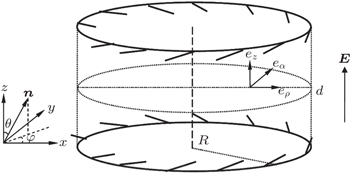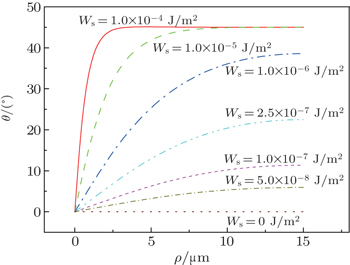† Corresponding author. E-mail:
‡ Corresponding author. E-mail:
Project supported by the National Natural Science Foundation of China (Grant Nos. 11374087, 11274088, and 11304074), the Natural Science Foundation of Hebei Province, China (Grant Nos. A2014202123 and A2016202282), the Research Project of Hebei Education Department, China (Grant Nos. QN2014130 and QN2015260), and the Key Subject Construction Project of Hebei Province University, China.
Based on the experimental phenomena of flexoelectric response at defect sites in nematic inversion walls conducted by Kumar et al., we gave the theoretical analysis using the Frank elastic theory. When a direct-current electric field normal to the plane of the substrate is applied to the parallel aligned nematic liquid crystal cell with weak anchoring, the rotation of ±1 defects in the narrow inversion walls can be exhibited. The free energy of liquid crystal molecules around the +1 and –1 defect sites in the nematic inversion walls under the electric field was formulated and the electric-field-driven structural changes at the defect site characterized by polar and azimuthal angles of the local director were simulated. The results reveal that the deviation of azimuthal angle induced by flexoelectric effect are consistent with the switching of extinction brushes at the +1 and −1 defects obtained in the experiment conducted by Kumar et al.
The flexoelectric effect in nematic liquid crystal (NLC) is a mechanoelectrical phenomenon analogous to piezoelectricity in solids.[1,2] The direction of axial symmetry is given by the director

Topological defects arise as a result of broken continuous symmetry and are ubiquitous in nature.[13–15] Commonly observed defects in the uniaxial nematic phase are typical point defects with topological charge S = ±1 and line defects with topological charge S = ±1/2.[16] The region where the presence of a defect causes apparent deviations from bulk ordering is referred to as the defect core.[17] Its linear dimension is roughly given by the correlation length of the order parameter field employed to describe the phase transition.[18] Nematic layers aligned planarly between unidirectionally rubbed plates with weak anchoring often exhibit narrow inversion walls containing several linear defects normal to the sample plane.[19] In 2006, Kumar et al.[12] sandwiched butyl 4-(4-ethoxyphenoxycarbonyl) phenyl carbonate (BEPC) between glass plates coated with ITO, which were rubbed unidirectionally on silk prior to cell construction and no surfactant material was used for securing a planar alignment. As seen between crossed polarizers, the inversion surface walls containing linear defects of charge ±1 were exhibited. When the substrates were applied a direct-current (DC) field, the extinction cross at a given defect was observed to rotate clockwise or anticlockwise, depending on the field direction. The extent of rotation was found to be linear with field, indicating its flexoelectric origin.
In a previous study, Tian et al.[20] investigated the interaction between a +1 defect whose nuclei is ‘circular’ nuclei (i.e., the director flux lines around the defect nuclei are circular) and the surface wall and flexoelectric response at the defect site, using the one-dimensional finite-difference iterative method based on the Landau–de Gennes theory. They found that the deviation of azimuthal angle of the director around the defect nuclei increases gradually with the increase of the electric field intensity. Therein, they only considered cylindrically symmetric solutions containing the +1 defect. However, the cylindrical symmetry is broken in the case of −1 defect, in which different phenomena need to be further researched.
The brief purpose of this paper is to give the theoretical analysis of the influence of the flexoelectric effect on the ±1 defect sites in nematic inversion walls based on the Frank theory. In Section 2, we first describe the structure of the defect site in the nematic inversion wall and obtain the free energy of NLC molecules around the defect site with an external DC electric field, and then deduce the equilibrium equations. Based on the equilibrium equations, the numerical results of the deviation of azimuthal and polar angles for the director around the defects site are simulated in Section 3. Meanwhile, we still analyze the influence of the surface anchoring strength and the flexoelectric effect on the simulated results and explain the experimental phenomenon conducted by Kumar et al. The conclusion is given in Section 4.
Let us consider NLC BEPC in the defect site confined between two plate substrates z = 0 and z = d with weak anchoring. The ±1 defects and two plate substrates can exhibit a cylinder-like structure (but generally without cylindrical symmetry), and the z axis of the cylinder is normal to the LC cell, as shown in Fig.
To describe this cylindrical defect we introduce standard cylindrical coordinate (ρ, α, z) and the corresponding local frame (eρ, eα, ez). The director of NLC in cylindrical coordinate can be written as
From the elastic continuum theory of LC, the bulk free energy density of the above system fbulk contains elastic, dielectric, and flexoelectric contributions, but because the value of dielectric anisotropy Δε for BEPC is very small,[12] the dielectric contribution can be ignored. Therefore, the bulk free energy density fbulk can be written as


The surface energy density fs, describing the interaction between the NLC molecules close to the substrate and the substrate itself, is given by


Taking into account the bulk free energy and the surface energy, the total energy of defect system Ftotal can be given by


For the +1 defect, the NLC texture exhibits a cylindrical symmetry, so the director is independent of α and z and is just a function of radius ρ. The value of S is +1 and the value of C is 0 or π/2. Here, we choose C = π/2, then φ = Sα + C = α + π/2. Hence, the director profile in the mid-plane z = d/2 with E = 0 is shown in Fig.

Considering the effect of an applied electric field, the total free energy density ftotal can be given by
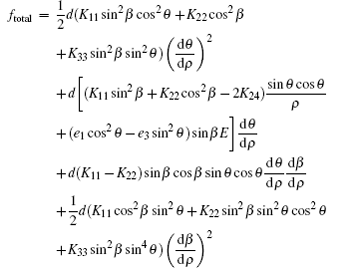

For the −1 defect, the cylindrical symmetry is broken. The director is the function of both α and ρ. The value of S is −1 and C = 0 is chosen, then φ = Sα + C = –α. Hence, the director profile in the mid-plane z = d/2 with E = 0 is shown in Fig.

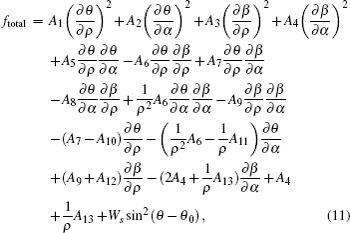


For a given applied voltage, the equilibrium configuration of NLC should make the total free energy density ftotal minimization, satisfying the following Euler–Lagrange equations:[1]


The boundary conditions for ±1 defects on the core of the defect (ρ = 0) and the lateral walls (ρ = R) are described as


Inserting the total energy density ftotal of +1 and −1 defect systems, Eqs. (
The change of NLC director is described by angles θ and β. In the numerical relaxation method,[24–27] the angles θ and β can be calculated by the following expressions respectively:




The stable solution of the angles θ and β must satisfy Eqs. (
Similar to the parallel aligned cell, the surface anchoring strength of the substrate has an important influence on the orientation of LC molecules in ±1 defects. Figures
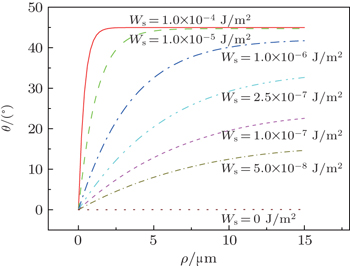 | Fig. 4. Polar angle θ versus radius ρ inside the +1 defect for different surface anchoring strengths Ws. |
We simulate angles θ and β as functions of radius ρ inside the +1 defect for different external applied voltages. The typical director profiles of θ and β inside the +1 defect are given in Figs.
 | Fig. 7. Deviation of azimuthal angle β versus radius ρ inside the +1 defect for different external applied voltages. |
 | Fig. 8. Polar angle θ versus radius ρ inside the −1 defect in 45° directions for different external applied voltages. |
For the +1 defect, figure
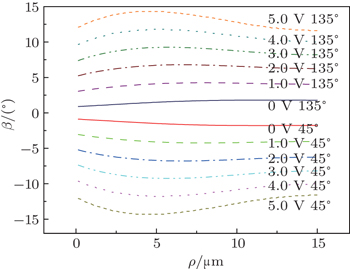 | Fig. 9. Deviation of azimuthal angle β versus radius ρ inside the −1 defect in 45° and 135° directions for different external applied voltages. |
 | Fig. 10. Deviation of azimuthal angle β versus angle α inside the −1 defect at the lateral walls (ρ = R) for different external applied voltages. |
For the −1 defect, polar angle θ decreases gradually in the direction α = 0° and increases gradually in the directions α = 45° and 90° with the increase of the external voltage, the angle β versus radius ρ in 45° directions for different external applied voltages are shown in Fig.
We still took out the angle β of the director for ρ = 3 μm, ρ = 6 μm, ρ = 9 μm, ρ = 12 μm, and ρ = 15 μm with different external voltages inside the +1 defect, as shown in Fig.
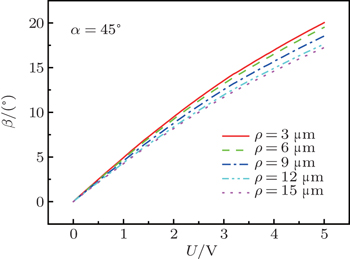 | Fig. 11. Deviation of azimuthal angle β versus external applied voltage U inside the +1 defect with ρ = 3 μm, ρ = 6 μm, ρ = 9 μm, ρ = 12 μm, and ρ = 15 μm. |
In 2006, the experiment of flexoelectric response at defect sites in nematic inversion walls was conducted by Kumar et al. The corresponding theoretical analysis of the influence of flexoelectric effect on +1 defect has been done based on the Landau-de Gennes theory by Tian et al. However, no one has done a theoretical analysis of −1 defect because the cylindrical symmetry is broken in the −1 defect and the corresponding calculation process is more complicated than +1 defect regardless of the application of Landau–de Gennes theory and Frank theory. In this paper, the influence of flexoelectric effect on the ±1 defect sites in nematic inversion walls is investigated based on the Frank theory. On application of a DC electric field normal to the LC cell, which exhibits narrow inversion walls containing defects of charge ±1, the polar angle θ and the deviation of azimuthal angle β influenced by flexoelectric effect have been simulated for illustrative purpose. In this way, we characterize the field-driven structural changes at ±1 defect sites. For +1 defect, the deviation of azimuthal angle β increases gradually with the increase of the external applied voltage and the sense of rotation for the angle β will reverse when the electric field is reversed. For −1 defect, the deviation of azimuthal angle β in the directions α = 45°, 135° increases gradually in opposite senses, in a scissoring fashion, and deviation of azimuthal angle β in the directions α = 0°, 90° have no evident rotational motion with the increase of the external voltage. The angle β is linear with the external voltage U for the ±1 defects. These conclusions are consistent with the experimental results of Kumar et al. In a word, the influence of the flexoelectric effect on the ±1 defect sites in nematic inversion walls seems to account for the experimental results of Kumar et al., i.e., clockwise or anticlockwise rotation of extinction cross at ±1 defects. The theory model has a certain theoretical significance to research defects in liquid crystal.
| 1 | |
| 2 | |
| 3 | |
| 4 | |
| 5 | |
| 6 | |
| 7 | |
| 8 | |
| 9 | |
| 10 | |
| 11 | |
| 12 | |
| 13 | |
| 14 | |
| 15 | |
| 16 | |
| 17 | |
| 18 | |
| 19 | |
| 20 | |
| 21 | |
| 22 | |
| 23 | |
| 24 | |
| 25 | |
| 26 | |
| 27 |



